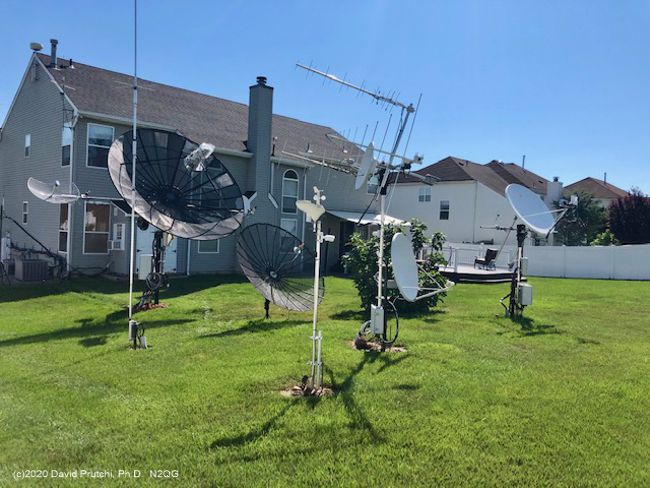I updated and greatly expanded my October 2020 whitepaper “Amateur DSN Lessons Learned (so far…).” The new version is available at: Amateur_DSN_Prutchi_2023. It is meant to supplement my presentation at the 2023 Hackaday Superconference.
Category Archives: Amateur Radio N2QG
Upcoming Talk at Hackaday Supercon 2023: Receiving Microwave Signals from Deep-Space Probes: Amateur DSN and the Ultimate DX.”

I’m excited to announce that I’ll be presenting “Receiving Microwave Signals from Deep-Space Probes: Amateur DSN and the Ultimate DX” at the 2023 Hackaday Superconference (Nov 3 – 5, 2023).
S-Band Spacecraft Receptions
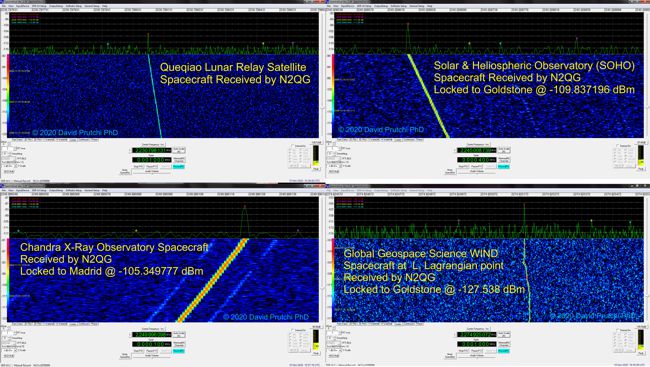
After some time of not looking at S-band, today I used the 1.5m dish to receive some S-band spacecraft. My receptions for today: Wind, Chandra, SOHO, and Queqiao.
OSIRIS-REx Two Days Before First Sample Collection Attempt

Sanity check after moving the X-Band system from the 1.2m offset dish to the 3.5m dish. OSIRIS-REx (Origins, Spectral Interpretation, Resource Identification, Security-Regolith Explorer) spacecraft comes in strongly two days before its first sampling attempt of asteroid Bennu.
Received MAVEN Orbiter at 8.4457 GHz

New one to me: received the fast-moving Mars Atmosphere and Volatile EvolutioN (MAVEN) orbiter while locked to Madrid DSN using the 1.2m offset dish antenna.
Recap of X-Band DSN Activities and Plans for the Future
I’ve been working on my system for receiving signals from deep-space spacecraft since the summer of 2019 when KC2TDS and I built an X-band circular polarization feed and downconverter that we tested at MUD 2019.
My first true-DSN X-band reception happened in May 2020. I was able to receive and track Bepi-Colombo, which at that time was 15.2 million km away from Earth. The signal was received with the feed built by KC2TDS mounted on a 1.2m f/d=0.6 offset dish steered by a Yaesu G-5500 az/el rotator. I used a Kuhne LNA-8000B low-noise amplifier connected directly to the probe, and the amplified signal was sent to the N2QG downconverter (LO=8GHz) mounted on the boom. Downconverted signals (400 – 450 MHz) were received using an AOR AR-5000. The radio’s IF was sampled by an SDR-14 and displayed with SpectraVue. Tracking of the probe was with PstRotator’s DSN feature.
Figure 1 – Block diagram of N2QG’s X-band Amateur DSN station in June 2020.
I purchased a squeezed-tube depolarizer and super Kumar scalar ring from M0EYT (from uhf-satcom.com). KC2TDS terminated it with a waterjet-cut copper disk and added a probe which he carefully tuned with the VNA to get <20dB return loss in the 8.4 to 8.45GHz DSN band. I mounted this feed on my 3.5m dish and was able to receive Mars Express, MRO, and OSIRIS-ReX.
Despite carefully tweaking the feed, I’ve been unable to get the system mounted on the 3.5m dish to yield the signal levels that I’m expecting. I suspect surface accuracy is the culprit because the 3.5m dish behaves well at 1296 MHz, but the g/t is just not there at 8.45 GHz. I can receive Bepi-Colombo on the 1.2m dish with around 12 dB compared to 16dB on the 3.5m dish. However, M0EYT receives it at around 30dB on his 2.4m prime dish. In July I worked on decreasing the SNR of the downconverter, which improved signals some, but definitely not as much as I would have liked to receive from a 3.5m dish.
Towards the end of that month I returned the X-band feed and downconverter to the 1.2m offset dish because I needed the 3.5m dish to participate in the EME SSTV Moon Landing Party hosted by PI9CAM at Dwingeloo Radio-Observatory in the Netherlands.
The Hope Emirates Mars Mission (EMM), Mars 2020 Perseverance, and Tianwen-1 launched right around that time, and I’ve been able to track them all with the 1.2m dish.
Juno remains out of my reach, so I’m considering next steps to improve my system. I thought that this would be a good point in time to summarize my experience so far, and discuss out loud plans for the future in case that it helps someone else who is just getting started in Amateur DSN. CLICK HERE for my whitepaper “Amateur DSN Lessons Learned (so far…).”
ARISS SSTV Event Commemorating Launch of Sputnik-1

This was a really difficult set to receive. Took 3 days worth of passes to receive all 16 images.
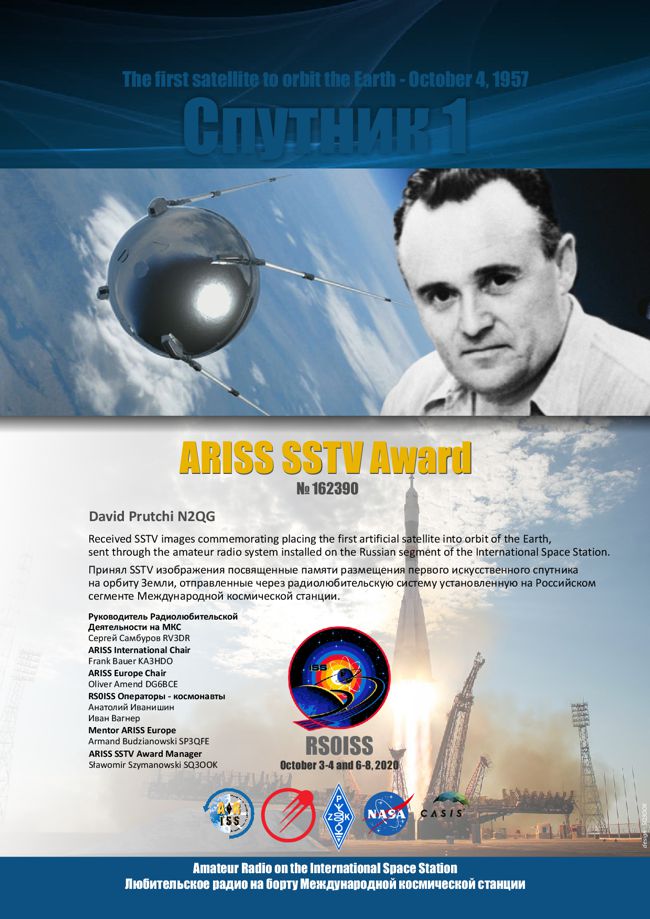
Strong Signals from Mars 2020 Perseverance and Tianwen-1
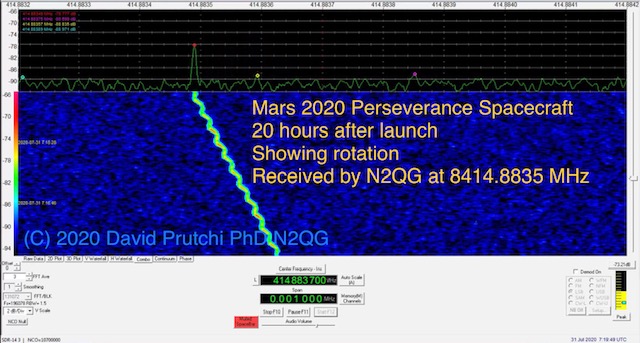
Woke up in the middle of the night to take a look at the signal from Mars 2020 launched yesterday morning. The signal exhibits a rotation Doppler component.
M0EYT let the Amateur DSN group know that Jon at JPL had loaded Tianwen-1’s ephemeris to Horizons, so I quickly added it to PstRotator:
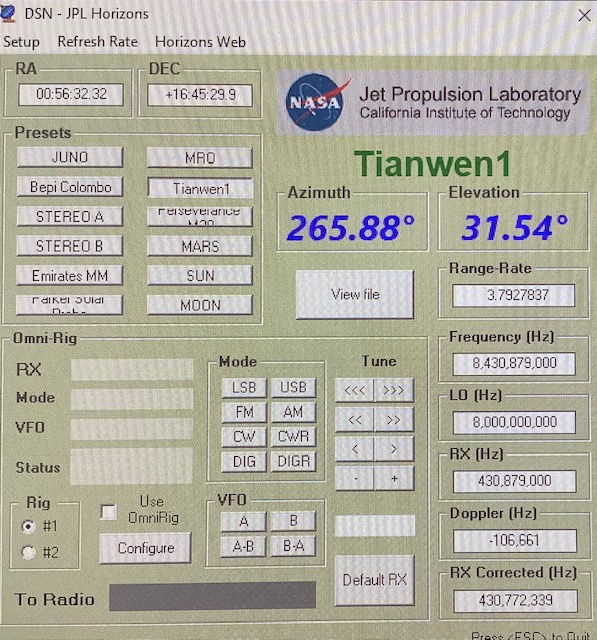
I’d seen the reports on the strength of its x-band signal, but holy mackerel, it is huge even on my 1.2m offset dish at a range of 2.6 million km!
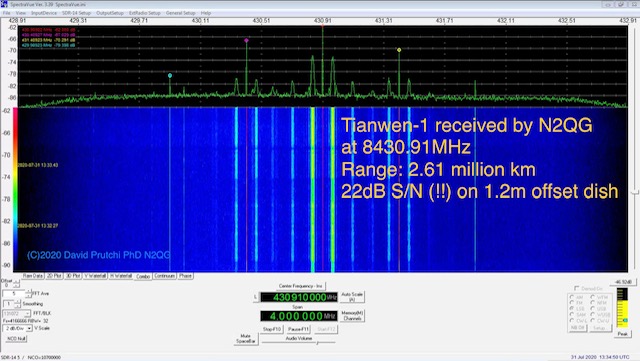 My plan for this weekend is to move the dual-polarization VE4MA feed to the 3.5m dish to track the Mars-bound flotilla (Emirates Mars Mission, Mars 2020, and Tianwen-1).
My plan for this weekend is to move the dual-polarization VE4MA feed to the 3.5m dish to track the Mars-bound flotilla (Emirates Mars Mission, Mars 2020, and Tianwen-1).
PI9CAM EME SSTV Lunar Landing Party was a Blast!

Had so much fun today receiving the images transmitted by the Dwingeloo Radio Observatory’s PI9CAM team via 1296 MHz EME SSTV to celebrate the 51st anniversary of the Apollo XI Moon Landing!
As an added bonus, PI9CAM was able to receive the images that I transmitted with my 3.5m dish and 400W at the feed.
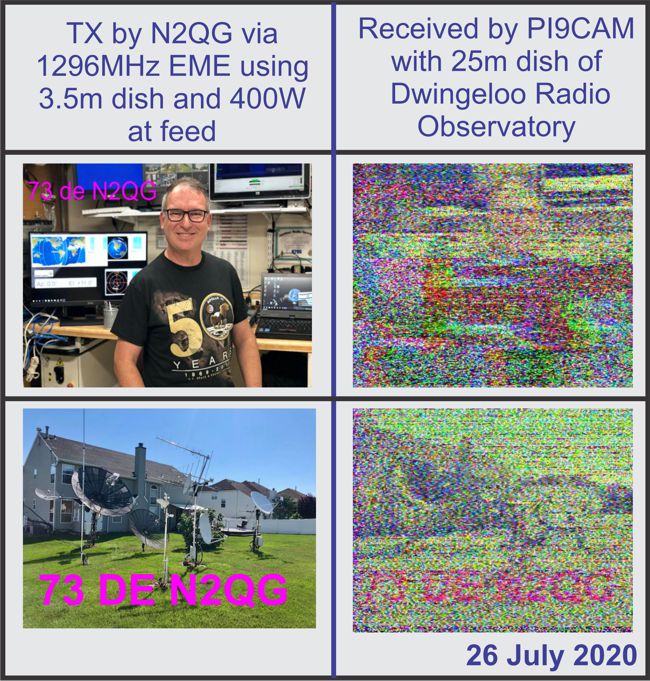
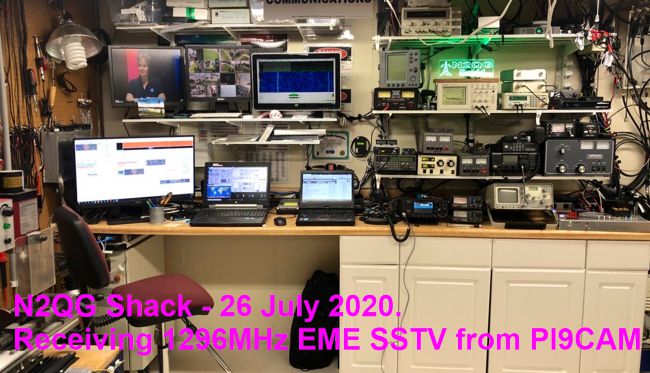
Hope Mars Mission Spacecraft (EMM) Acquired Overnight
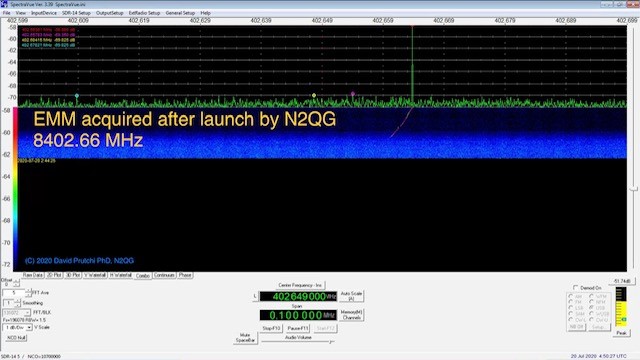
The Emirates Hope Mars Mission (EMM) Spacecraft launched yesterday from Japan using a Mitsubishi Heavy Industries H-IIA launcher. I was able to acquire its signal as soon as it cleared my local horizon. The screenshot above shows my house’s thermal noise fading away as the spacecraft gained elevation, to finally yield a clean signal past midnight (local time). Continue reading


